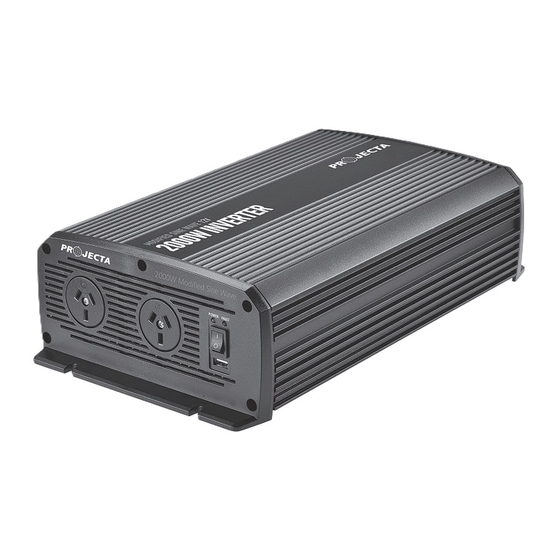
Summary of Contents for Projecta IMW300
- Page 1 CONVERTS 12 VOLT DC – 230 VOLT AC POWER INVERTER POWERS HOUSEHOLD APPLIANCES FROM A 12 VOLT BATTERY P/No.s IMW300, IMW600, IMW1000, IMW2000...
- Page 2 • Heavy Duty power leads for direct battery connection. • Approved AS/NZS power outlet sockets. • Twin power outlet sockets (except IMW300). • 5V DC 2.1A USB power socket. • Axial cooling fan. • Temperature controlled automatic cooling fan (except IMW300).
- Page 4 WHAT IS AN INVERTER? Inverters are designed for powering household appliances from a battery or vehicle. They are electronic devices that convert (12V DC) battery power to (230V AC) mains power. Inverters are compact and often lightweight making them an ideal source of portable mains power. Thanks to their portability they are commonly used in cars, caravans, motor homes, boats, 4WD’s and utility vehicles.
- Page 5 CONNECTIONS / CONTROLS & ACCESSORIES After unpacking your inverter take a moment to check that you have all the correct accessories for your model and familiarise yourself with the connections and controls. P/No. IMW300 AC OUTPUT POWER & FAULT SOCKET...
- Page 6 • For vehicle or camping use the inverter must be protected from rain, water or moisture. Projecta inverters are designed for indoor, out of weather use only. For best performance the inverter must be used or mounted in a cool, dry, clean and well-ventilated area.
- Page 7 • Batteries can be dangerous, follow all battery manufacturer’s instructions and warnings. • Projecta inverters are designed FOR INDEPENDENT USE ONLY. That is, they cannot be connected to household wiring whether the building is connected to the electricity grid or not.
- Page 8 TEMPORARY CONNECTION: • Connect the ring terminal on the negative lead (Black) to the negative (Black) DC terminal on the back of the inverter. • Connect the battery clip (Black) or ring terminal (IMW1000, IMW2000) on the other end of the lead to the negative DC supply or (-) battery terminal.
- Page 9 If longer cables are required only use suitably insulated automotive battery cable according to the following table (Note: B&S = AWG) P/No. IMW300 IMW600 IMW1000 IMW2000 Up to 2m 8 B&S 6 B&S 3 B&S 2 B&S...
- Page 10 EXTERNAL EARTHING: (OPTIONAL) Projecta inverters have been internally bonded for safety, by connecting the AC socket/s earth pin to the inverter case and to the DC negative supply input. Because of this most installations do not require the inverter to be earthed. However if the inverter is used in a stationary land based application or if the inverter is causing interference with TV sets or radios it is recommended that an external earth connection is made by one of the following methods:.
- Page 11 If this occurs, IMW300 will automatically recover once the load is reduced. All other inverter models will need to be manually reset by switching off the appliance and the inverter.
- Page 12 (Watts) used or the current (Amps) drawn under normal use. The following table shows the maximum combined AC Watts or AC Amps which can be run by the inverter. P/No. IMW300 IMW600 IMW1000 IMW2000 AC Combined max load (Watts)
- Page 13 CONNECTING APPLIANCE AND RUNNING INVERTER • Connect the appliance AC plug to the inverter AC outlet socket. • Switch the inverter “ON”, the “Green” power light will illuminate to indicate operation. • inverter on before switching the appliance on and always turn the appliance off before switching the inverter off.
- Page 14 TROUBLESHOOTING / FAQ: Q. Why does the inverter turn itself off? A. If the inverter makes a beep sound and/or the “RED” fault light illuminates this indicates that there is a problem, and the inverter will usually turn off. Most commonly this would be caused by an appliance that is drawing too much power (overloading), low battery voltage or voltage drop due cient size cables or poor connections (see section on protection features, page 11).
- Page 15 Q. How do I check or change the fuses? The IMW300 inverter is fitted with one external fuse holders. If the unit does not function, disconnect the inverter from the DC power source and disconnect any AC appliances.
- Page 16 Q. Why does my Residual Current Device (RCD) trip each time I turn an appliance on? A. Some RCD’s disconnect (trip) when they do not receive any power. These types of RCD’s can be tripped by the inverter’s Peak Power Technology which allows a gradual ramp up of power. Use a continuous RCD which does not trip out when the power is turned off, these only trip when there is a fault.
- Page 17 NOTES...
- Page 18 NOTES...
- Page 19 NOTES...
- Page 20 WARRANTY STATEMENT APPLICABLE ONLY TO PRODUCT SOLD IN AUSTRALIA Brown & Watson International Pty Ltd of 1500 Ferntree Gully Road, Knoxfield, Vic., telephone (03) 9730 6000, fax (03) 9730 6050, warrants that all products described in its current catalogue (save and except for all bulbs and lenses whether made of glass or some other substance) will under normal use and service be free of failures in material and workmanship for a period of one (1) year (unless this period has been extended as indicated elsewhere) from the date of the original purchase by the consumer as marked on the invoice.









Need help?
Do you have a question about the IMW300 and is the answer not in the manual?
Questions and answers